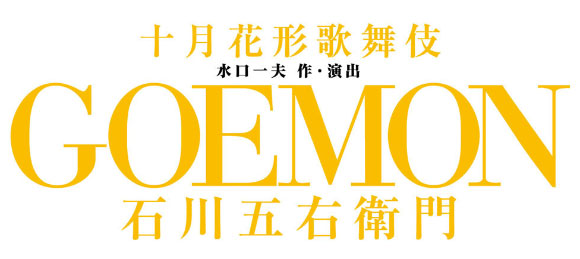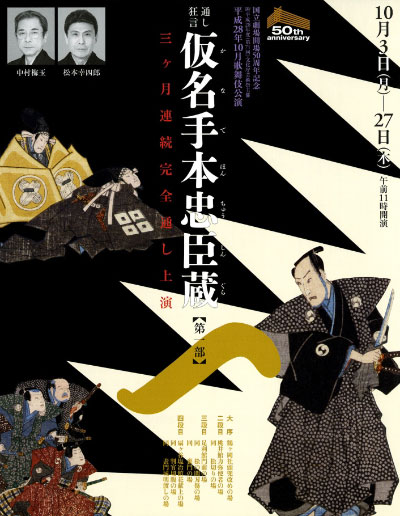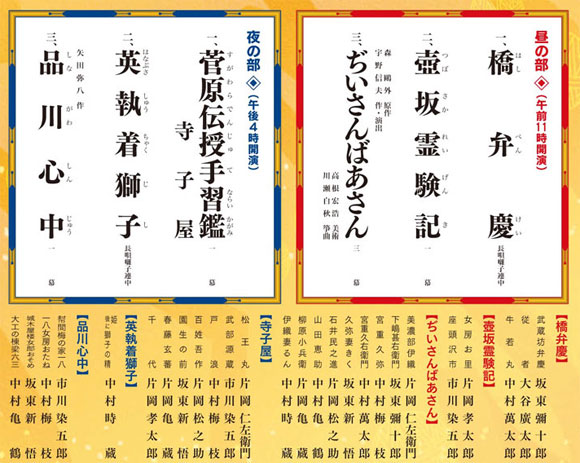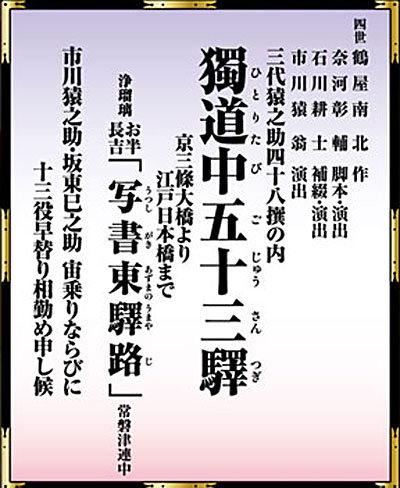| OCTOBER 2016 |
| Kabukiza (T˘ky˘) |  |
| Dates | 2 ~ 26 October 2016 (Jűgatsu ďkabuki) October Grand Kabuki |
| MatinÚe |
Ho Agete I˘ Takarabune |
| Evening | |
| Casting |
Living National Treasure Sakata T˘jűr˘, Living National Treasure Onoe Kikugor˘, Living National Treasure Nakamura Kichiemon, Living National Treasure Band˘ Tamasabur˘, Living National Treasure Nakamura T˘z˘, Nakamura Shikan, Nakamura Jakuemon, Onoe Kikunosuke, Nakamura Shichinosuke, Nakamura Kaishun, Onoe Sh˘roku, Nakamura Karoku, Nakamura Matagor˘, Onoe Matsuya, Nakamura Kotar˘, Nakamura Hashinosuke, Nakamura Fukunosuke, Nakamura Utanosuke |
| Comments |
Nakamura Hashinosuke III takes the prestigious name of Nakamura Shikan VIII! His three sons Nakamura Kunio, Nakamura Muneo and Nakamura Yoshio take the names of Nakamura Hashinosuke IV, Nakamura Fukunosuke III and Nakamura Utanosuke IV. Nakamura Shikimatsu II, a disciple of late Nakamura Shikan VII, joins the first league of Kabuki actors (kanbu sh˘shin) and receives the name of Nakamura Baika IV.
|
 |
| Shinbashi Enbuj˘ (T˘ky˘) |  |
| Dates | 3 ~ 27 October 2016 (Jűgatsu Hanagata Kabuki) October Young Actors Kabuki |
| Program |
GOEMON-Ishikawa Goemon |
| Casting |
Kataoka Ainosuke, Nakamura Ganjir˘, Kamimura Kichiya, Nakamura Kazutar˘, Nakamura Tanenosuke, Nakamura Jűjir˘, Imai Tsubasa |
| Comments |
A dance drama first performed in 2011 presenting the mysterious life of Ishikawa Goemon (Kataoka Ainosuke) with a new perspective. It is the time after the unification of Japan by Toyotomi Hideyoshi (Nakamura Ganjir˘) in the 16th century. There are several cathedrals seen in each place of Japan as a few decades have passed since Christianity has first been missioned in Japan. Ishida no Tsubone (Kamimura Kichiya), a daughter of Akechi Mitsuhideĺs chief retainer Shioden Tajima-no-Kami, hates Hideyoshi and seeks opportunity to avenge her father on him. As she learns Christianity from Father Calderon (Imai Tsubasa), she has come to forget her hatred against Hideyoshi. Love has grown between her and Calderon, and Tomoichi is born between them. Calderon resigns as a priest because he has broken the law as a priest, and chooses to live together with his wife and son. 7 years later Hideyoshi prohibits Christianity to be propagated in Japan. Calderon is banished from Japan and goes back to Spain. Hideyoshi wants to make her his own and summons her to his palace Jurakudai, since he has fancied her for years. She tries in vain to kill him and dies. Having lost his parents, Tomoichi grows up to be a robber and calls himself Ishikawa Goemon who causes a great sensation in Japan. He watches eagerly for a chance to avenge his parents on Toyotomi Hideyoshi. Goemon outwits Hideyoshi and succeeds in freeing Izumo no Okuni (Nakamura Kazutar˘) from him. She is Nagoya Sanzaĺs wife and a popular dancer in Ky˘to. It turns out that Sanza (Kamimura Kichiya) is a son of Akechi Mitsuhideĺs retainer Yasuda Sakubŕ. Goemon, Okuni and Sanza cooperate to defeat their common enemy Hideyoshi. Okuni takes great pains how she becomes the center of attention among people. Goemon teaches her flamenco the dance of his fatherĺs country as a hint for the new dance. But Goemon is being besieged from all sides. Enjoy a novel Kabuki dance which has taken in flamenco. |
 |
| National Theatre (T˘ky˘) |
| Dates | 3 ~ 27 October 2016 |
| Program |
|
| Casting |
Matsumoto K˘shir˘, Nakamura Baigyoku, Nakamura Senjaku, Ichikawa Sadanji, Kataoka Hidetar˘, Nakamura Kinnosuke, Ichikawa Danz˘, Band˘ Hikosabur˘, ďtani Tomoemon, Ichikawa Komaz˘, Ichimura Manjir˘, Band˘ Shűch˘, Matsumoto Kingo, Nakamura Matsue, Sawamura S˘nosuke, Sawamura Yoshijir˘, ďtani Keiz˘, Arashi Kitsusabur˘, Ichimura Kitsutar˘, Ichimura Takematsu, Nakamura Hayato, Nakamura Yonekichi, Ichikawa Otora |
| Comments |
First month of the t˘shi ky˘gen production of the classic "Kanadehon Chűshingura" to celebrate the 50th anniversary of the opening of the National Theatre! The play "Kanadehon Chűshingura" (The Treasure of 47 Loyal Retainers) is the most popular in the Kabuki repertory and is known throughout the world.
|
 |
 |
| Nagoya (NTK Hall) |
| Dates | 2 ~ 26 October 2016 (Kinshű Nagoya Kaomise) Autumn Brocade Nagoya Face-Showing Program |
| MatinÚe | |
| Evening |
Sugawara Denju Tenarai Kagami (Terakoya) Shinagawa Shinjű |
| Casting |
Living National Treasure Kataoka Nizaemon, Nakamura Tokiz˘, Ichikawa Somegor˘, Kataoka Takatar˘, Band˘ Yajűr˘, Kataoka Kamez˘, Nakamura Kikaku, Nakamura Baishi, Nakamura Mantar˘, Band˘ Shingo, Kataoka Matsunosuke, ďtani Hirotar˘ |
| Comments |
The October kaomise programs in Nagoya. As the Misonoza closed in Spring 2013, these programs are staged at the Nihon Tokushu T˘gy˘ Shimin Kaikan for the fourth time, a venue commonly called NTK Hall in Nagoya.
|
 |
| Sh˘chiku Grand Kabuki Tour | |
| Dates | 1 ~ 26 October 2016 (Sh˘chiku ďkabuki) Sh˘chiku Grand Kabuki |
| Program | |
| Casting |
Ichikawa Ennosuke, Band˘ Minosuke, Ichikawa Monnosuke, Ichikawa Emisabur˘, Ichikawa Emiya, Ichikawa Juen, Ichikawa Shun'en, Ichikawa En'ya |
| Comments |
The spectacular drama "Hitori Tabi Gojűsan Tsugi", which belongs to the Ennosuke Jűhachiban collection of plays, is staged for the very first time on tour. This drama full of keren is produced in a lighter version (less roles to be performed) but the amazing chűnori with the huge cat-spirit is part of the production. Depending on the city, there is either one program (A prog) or two programs (A prog in the afternoon, B prog in the evening). In A prog, Ichikawa Ennosuke plays the roles of Yurugi Shirabenosuke and the old woman Osan, in reality the cat-spirit of Okazaki. Band˘ Minosuke plays 13 roles. In B prog, it is the opposite.
|
 |
| Classics Tour | |
| Dates | 1 ~ 26 October 2016 (Aki no Tokubetsu K˘en ~ Koten he no Izanai) Fall Special Performances ~ Invitation to the Classics |
| Program | |
| Casting | |
| Comments |
An original tour, which mixes N˘ and Kabuki. The first item is the N˘ drama "Ataka". The second item is the famous dance-drama "Kanjinch˘", which is the Kabuki version of "Ataka". |
| NHK Hall (T˘ky˘) | |
| Dates | 28 October 2016 (Koten Gein˘ Kansh˘ Kai) |
| Program | |
| Casting |
Living National Treasure Nakamura T˘z˘, Nakamura Baigyoku, Nakamura Jakuemon, Nakamura Kinnosuke, Ichikawa Komaz˘, Nakamura Matsue, Band˘ Kamesabur˘, Band˘ Kametoshi, Nakamura Hayato, Ichimura Kitsutar˘, Arashi Kitsusabur˘ |
| Comments |
43rd edition of Koten Gein˘ Kansh˘ Kai (literally the "Classics Entertainment Appreciation Association"), a yearly performance produced by the National TV network NHK. The program includes traditional music, one ky˘gen and one Kabuki drama.
|
|
|||
| Dates | 29 October ~ 3 November 2016 (Band˘ Tamasabur˘ Tokubetsu Buy˘ K˘en) Band˘ Tamasabur˘ Special Dance Performances |
||
| Program |
Aki no Irokusa |
||
| Casting |
Living National Treasure Band˘ Tamasabur˘ |
||
| Comments |
A special Buy˘ program starring the amazing Living National Treasure onnagata Band˘ Tamasabur˘ in Yamaga at the Yachiyoza, a traditional wooden-built theater.
|
||
|
|||
| Dates | 27 October 2016 (Enshi no Kai) Enshi Gala |
||
| Program |
Seigaiha |
||
| Casting |
Ichikawa Enshi |
||
| Comments |
3rd edition of the gala for the young actor Ichikawa Enshi, a disciple of Ichikawa Ennosuke. |
||
|
|
| Contact | Main | Top | Updates | Actors | Plays | Playwrights | Programs | Links | FAQ | Glossary | Chronology | Illustrations | Prints | Characters | Derivatives | Theaters | Coming soon | News |
